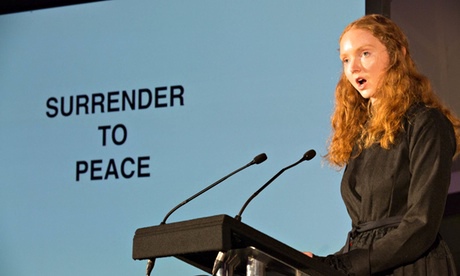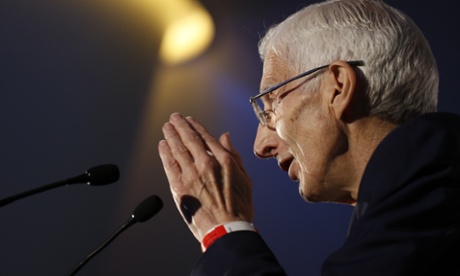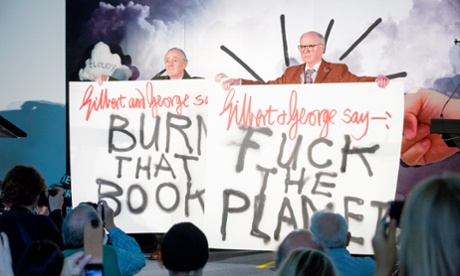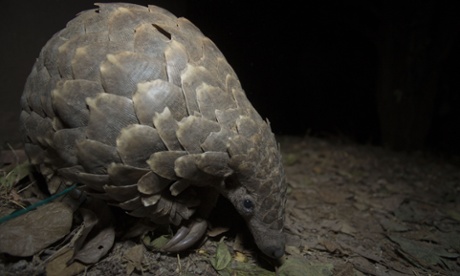The Extinction Marathon: the art world's bid to save the human race
Yoko Ono, Gilbert and George, Gustav Metzger, Lily Cole and dozens of scientists and anthropologists come together at London’s Serpentine Gallery to confront the end of humanity

On Saturday, one of the seven northern white rhinos left on this planet died, leaving just a single breeding male to ensure the survival of a species aggressively hunted into near-extinction.
This was the haunting and apt backdrop for the ninth festival of ideas held at London’s Serpentine Gallery, a two-day marathon that this year grappled with the topic of extinction and the worryingly prescient spectre of the end of the human race.
With contributions from over 80 figures, from artists to poets, scientists and anthropologists, writers and philosophers over two days, the Extinction Marathon sought to illustrate how human excess and consumption has led the natural world, and therefore our own race, to the brink of extinction. More than just a meeting of minds and a platform for new art, this year’s Marathon, said Serpentine Gallery director Julia Peyton Jones, would act as a “clarion call for action”.
The driving force behind the extinction theme was Gustav Metzger, the 88-year-old artist and political activist who acted as a co-curator. It was born out of a discussion around his 2009 show at the Serpentine, Facing Extinction, which addressed society’s overconsumption of information, and Metzger was described by Peyton Jones as the “inspiration and guiding light” of the Extinction Marathon.
Hans Ulrich Obrist, co-director of the Serpentine who conceived the Serpentine’s annual marathon series, said: “Gustav told me it is just not enough to talk about climate change, we will never wake up. We have to talk about extinction ... We may not be in the first phase of globalisation but we are living in the most extreme, and the result of homogenisation has led to the disappearances of species, languages and even entire cultures. In our consumerist society we become tied to an endless chain of extinction and creation which is not sustainable.”

He added: “We do not see this as just a two-day event, we see the Extinction Marathon as a movement that will continue to evolve, raise awareness and create a legacy that extends beyond the physical encounter of our meeting here.”
Indeed Metzger was commissioned by The Space, the online arts platform from the arts council and the BBC, to create a special digital artwork for the Marathon – an online installation involving thousands of newspaper cuttings. Present for the whole event, he opened the Marathon with his own call to arms for fellow artists.
“I hope this particular meeting will extend our capacities to feel, to see and reimagine what humans are doing to animals, to plant life, to nature in the widest sense,” he said. “Art, throughout its history for thousands of years, has always been interacting with nature. There’s no art without nature ... so what can art do, what is the artist’s task? Their task is to emphasise, to remind people of the richness in nature and inspire people to want to protect this nature.”
The theme was interpreted in myriad forms over the weekend. Notable participants ranged from mathematician Marcus de Sautoy, who told three mathematical stories about extinction, and Turner-nominated artistCornelia Parker who gave a personal “tirade”, to a new sound installation of flocks of starlings by artist Chris Watson and a powerful lecture by Lord Martin Rees on the bleak prospects for humanity’s future. Susan Hiller also showed her film The Last Silent Movie, which collated sound recordings of hundreds of extinct, or endangered, languages from Cajun French to Ubykh.
On Saturday, the event also saw controversial artists Gilbert and Georgedebut a new manifesto. They both took to the stage holding up a large hand-painted piece of paper; one message read “BURN THAT BOOK” and the other “FUCK THE PLANET”. The pair held them aloft, unspeaking and unblinking, before exiting wordlessly.

The symbol for the Extinction Marathon was also particularly significant. The pangolin, a scaly anteater-like creature that is the most illegally traded mammal in the world, became a central feature of talks and specially commissioned works over the weekend. With over one million pangolins believed to have been poached from the wild in the past decade, the marathon held up the creature as an all-encompassing marker of extinction fuelled by human greed, an animal that Professor Jonathan Bailie, a global authority on the status and trends of threatened species, described as “one of the most magical creatures on the planet”.
It was a view echoed by Bafta-winning film-maker Adam Curtis, known for films such as Century of Self and All Watched Over By Machines of Loving Grace, who made a short film for the festival on the plight faced by the animal.
In another segment, Lebanese-American poet Etel Adnan did a reading from her 1989 work Arab Apocalypse, written in the wake of the Lebanese civil war, to illustrate her belief that “war is the worst form of extinction”.
Adnan continued: “It is not in the lineage of death and resurrection. War kills more than people, it kills ways of life, it kills equality of life, it kills what is human in life and in that sense it is the most serious form of extinction. When the war in Lebanon started, I had a feeling that not only was it going to last a long time but I feared that it would generate other wars – the beginning of an on-going apocalyptic era for that part of the world, and up to now, that has been unfortunately true. It has become an unceasing, searing, unrelenting extinction.”

The weekend was drawn to a close with a performance of a specially commissioned new work by Yoko Ono, called Bells for Serpentine, read by actress and model Lily Cole.
The audience were each handed a small bell, which they could sound at their will and were encouraged to make a wish as they did, creating a ringing cacophony as Cole read out Ono’s lyrics: “Uncover, not discover, you will see the miracles inside all things waiting to be uncovered while we are sitting in our heads. Don’t try to change the world, that’s a concept floating on our horizon. Just use your wits and change your heads.”
Speaking after the performance, Cole said the meditative piece spoke to her of the way “everyone is always trying to change the world from a very external perspective, without stopping and starting with yourself. I agree with Yoko that everything starts with ourselves – this piece was about us each taking our own responsibility for the way we perceive the world.”
Cole, who is a vocal environmental activist, added: “I was very impressed to see that extinction was the theme. I don’t think it’s spoken about often enough. We often hear about extinction of other species but we don’t hear about extinction of our own species, and I think that speaks to some kind of general denial that ultimately we are putting ourselves at risk if we continue to degrade the planet and I think that kind of discourse is necessary on all levels – personally, politically, artistically and socially. I don’t think you can isolate it on any one sphere.”
Summing up the marathon on Sunday night, Peyton Jones said she felt a line from a film by one of the marathon’s young exhibitors had encapsulated the weekend. “I think Benedict Drew’s film probably said it best,” she said, laughing. “We’re all done for and it’s all our fault.”
No comments:
Post a Comment